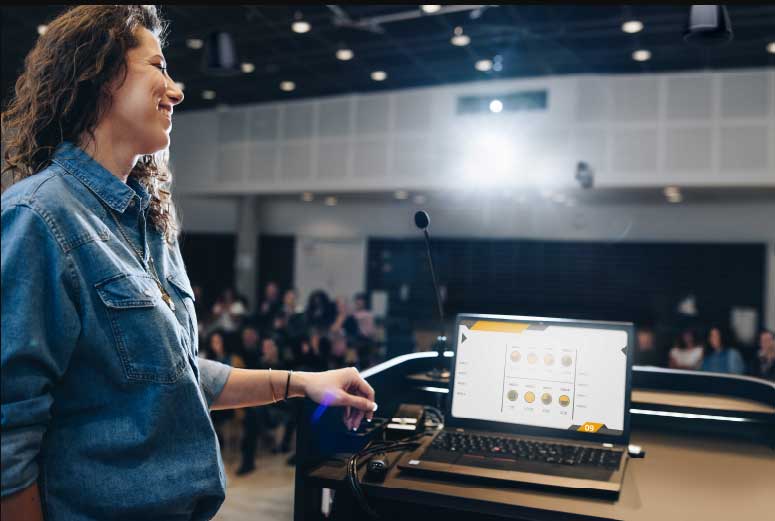A New Category of Meeting Space Emerging
Frost & Sullivan has noted the emergence of a new category of sophisticated meeting space characterized by an elevated user experience enabled by professional‐grade AV and control platforms. Traditionally, vendors and end-user organizations have characterized meeting spaces according to size, not the effect that the meeting space is designed to achieve.
We refer to the new category as “high-impact space” because the collaboration that takes place in high-impact spaces must achieve substantial, well-defined outcomes. In Frost & Sullivan’s opinion, high-impact spaces have become essential to the accomplishment and creativity of top teams worldwide.
High‐impact spaces gather influential stakeholders or large groups of people in highly visible spaces (e.g., flexible and divisible rooms, boardrooms, executive spaces; training and all‐hands rooms, and auditoriums). High-impact spaces include several combinations of advanced characteristics:
- High-impact spaces are dynamic, scalable, and sophisticated meeting spaces that employ professional‐grade AV and control platforms that integrate seamlessly with collaboration platforms to automate an elevated, experience for those on‐site, those off-site as well as an inclusive hybrid experience for all participants.
- High-impact spaces provide the flexibility to support a variety of engagements that often require feature sets including multi‐zone audio, video distribution, and room automation (such as automatic camera switching).
High-Impact Space: The New Vision for the Collaboration Experience
Going back to the workplace is vastly different from what we left behind pre-pandemic. According to Frost & Sullivan’s research (in collaboration with Q-SYS), only 9% of organizations in the United States will be fully office-based in 2023.
Improving the reliability, quality and robustness of the meeting spaces – ensuring the technology works every time with minimal support – remains a top concern for IT and AV professionals. Their ultimate goal is that the high-impact space shelter end-users from complexity, making professional-grade AV technology user-friendly. Other collaboration needs include flexibility, simplicity, automation, improved supportability, and standardization.
In the context of a hybrid workforce, audio performance is often a bigger pain point than video quality. Allowing all team members to hear and be heard properly is a high-priority goal. Decision-makers want to avoid a view-only experience for remote participants.
Features of high-impact spaces such as automatic camera switching and beamforming ceiling microphones help eliminate throw-away space at the far ends of meeting rooms, remove friction for human interaction from hybrid meetings and draw on-site users away from the proximity bias of too-easy communication with neighbors. It is about inclusion and creating the feeling everyone can participate, enabling new views and opinions to be heard. Importantly, the equitable experience must be a repeatable experience for every individual, not just a one-off.
Finally, stimulating employee self-fulfillment is the ultimate benefit of high-impact spaces. Individuals need to realize their full creative potential and not face obstacles to creativity. When they are remote, presenters want a visually more engaging presentation of themselves to the room.
High-Impact Spaces: A Triple-digit Billion Dollar Market
Frost & Sullivan estimates that 4.7 million high-impact spaces already existed in 2021. We expect that number to increase to 11.3 million worldwide in 2025, equal to 11% of all meeting spaces worldwide.
High-impact space penetration will rise gradually, and organizations will deploy high-impact spaces in three different scenarios. When an office moves, when existing buildings are renovated, and on a rolling basis when legacy equipment needs upgrading. This is significant because so many organizations are looking to reduce their real estate due to the proliferation of work-from-home practices. Fewer, but nicer offices, is the current mantra, which will drive high-impact space penetration.
Resources will be available to advance on high-impact spaces on the technology and digital transformation agendas because the vast majority of IT decision-makers surveyed by Frost & Sullivan expect their budgets to increase or, at least, remain the same. Organizations whose budgets remain unchanged will experience real-estate reduction and optimization leading to significant cost savings that can be pumped back into transformation projects, including high-impact spaces.
Frost & Sullivan estimates that the worldwide high-impact space market was worth $80 billion in 2021, and will rise to $139 billion in 2025.
The Last Word
High-impact spaces have the power to democratize work, giving everyone access to sophisticated meetings, and create a fun work environment and culture. Organizations want to motivate their employees to gather in the offices regularly to promote spontaneous collaboration, engagement and interaction. For those who cannot be present, offering a digital equivalent of the face-to-face experience is essential, and the high-impact space achieves that.
Ultimately, it is about satisfying end-user preferences: how they want to project themselves, and where they want to work. In fight for the top talent, skilled workers will not stick around if legacy collaboration and meeting technology projects them as bland and uninspiring.
Learn more about how to go beyond traditional meeting spaces and transform unused rooms into dynamic, high-impact spaces.










